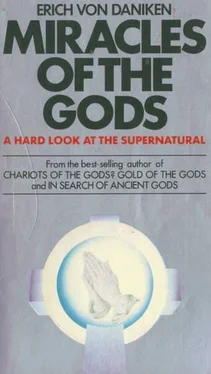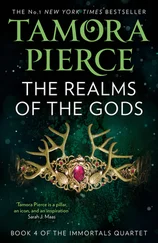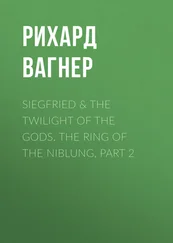Erich Daniken - Miracles of the Gods
Здесь есть возможность читать онлайн «Erich Daniken - Miracles of the Gods» весь текст электронной книги совершенно бесплатно (целиком полную версию без сокращений). В некоторых случаях можно слушать аудио, скачать через торрент в формате fb2 и присутствует краткое содержание. Жанр: Физика, на английском языке. Описание произведения, (предисловие) а так же отзывы посетителей доступны на портале библиотеки ЛибКат.
- Название:Miracles of the Gods
- Автор:
- Жанр:
- Год:неизвестен
- ISBN:нет данных
- Рейтинг книги:4 / 5. Голосов: 1
-
Избранное:Добавить в избранное
- Отзывы:
-
Ваша оценка:
- 80
- 1
- 2
- 3
- 4
- 5
Miracles of the Gods: краткое содержание, описание и аннотация
Предлагаем к чтению аннотацию, описание, краткое содержание или предисловие (зависит от того, что написал сам автор книги «Miracles of the Gods»). Если вы не нашли необходимую информацию о книге — напишите в комментариях, мы постараемся отыскать её.
Miracles of the Gods — читать онлайн бесплатно полную книгу (весь текст) целиком
Ниже представлен текст книги, разбитый по страницам. Система сохранения места последней прочитанной страницы, позволяет с удобством читать онлайн бесплатно книгу «Miracles of the Gods», без необходимости каждый раз заново искать на чём Вы остановились. Поставьте закладку, и сможете в любой момент перейти на страницу, на которой закончили чтение.
Интервал:
Закладка:
It is unfair to dispute the subjective 'truth' of their visions. If the Church does not want visions to exist on a large scale, it must change or exclude the training in readiness to receive experiences, the wish to be confronted with the Holy Family. That is something it will certainly not do, as it can make very good use of the so-called 'genuine' visions in its proselytizing work. Walter Nigg, the hagiographer already mentioned, who wanted to see the return of the saints, expresses a pious hope that is equally applicable to the 'necessity' of visions: 'Admittedly they are virtually forgotten nowadays; they are spoken of infrequently or not at all. Yet the silence will not endure, for suddenly they will speak to men again.' The Church, too, has its specific wish for pleasure, for pleasure in miracles.
In order to increase the procurement of pleasure in the faith, some tricks have been integrated into the Mass. The American Leslie M. LeCron[19] says that a burning candle is best suited for the stimulation of heterosuggestion (and what else is devotion?). It should be set up in such a way that it is pleasant to watch. 'The nickering flame of a candle has a hypnotic effect.' Campbell proved by experiments that white, with its many frequencies, provoked intense feeling, of pleasure. 'Brightness contrasts with the boring monotony of the surroundings and hence produces pleasure.'
Naturally the smart ecclesiastical bigwigs had no academic justification when they installed the Lucerna, or eternal lamp, before the altar as a 'sign of the presence of Christ as light of the world' (John
8, 12). But during its 2,000 years of history the Church has shown an infallible instinct, a sixth and seventh sense for 'effect'. For a long time now, the eternal lamp has not been confined to the interior of the Church. Candle stands offer the effective illumination for sale right at the entrance. There is not a single church without countless candles burning away before altar and high altar, before pictures of the Madonna and saints. They excite the desired raptures.
At places of pilgrimage candle orgies create Orphic mysteries which stimulate a state of preparedness for miracles with their sea of light. Torch- and candle-bearing processions are common on high holidays. In the light of present-day psychological knowledge, they effectively stimulate that state of
'being outside one's self in which even miracles still have a chance of being believed.
I have no intention of entering the boundless territory of psychology, but I should like to illuminate one sector which can answer some questions - I refer to the psychotherapeutic method of psychodrama.
A group of patients act out their conflicts to liberate themselves from their frustrations and neuroses.
The therapy effects a healing process.
Actually this highly modern concept can be found as early as the Greek philosopher Aristotle (384
B.C.-322 B.C.). Aristotle realized that ideas do not work outside, but in, the body as an effective force.
His idea of entelechy (= forming power) which he took over from physics was introduced into his moral philosophy which survived for centuries. According to it, the mind is matterless energy (= the first forming power). Tragedy, say Aristotle, achieves through catharsis (= purification), the decision between good and bad, a miraculous healing effect? (Psychodrama!).
Dr. Ploeger, a university lecturer [20] explains the process as follows: 'An implicit condition for it among the spectators is their identification with the hero, whose actions they accept and find in agreement with their own ideals and motives.' (Such identifications exist at all places of pilgrimage — with members of the Holy Family!) Dramatic representation of the conflicts effecting a cure in the Aristotelean sense produces effects much like those obtained by psychodrama as practised in western and eastern countries today.
In Chinese philosophy of the fourth and third centuries B.C. there existed the concept of the Tao, which means something like path or way. Tao was the world's primal cause, which was at the root of all phenomena, but was beyond rational perception. In this philosophy the Yin and Yang (dark and light) stand for positive and negative values. As Professor Ilza Veith [21] says in his essay 'Psychiatric Thought in Chinese Medicine', the Chinese have never, like other cultures, imagined their creator as a figure who demanded obedience and devotion. Undisturbed by a punitive vengeful god at the beginning of things, the Chinese sought edification and healing in the additive power of likeminded
'souls', in the grouping of family and friends. Here, too, the mind of a community which was fixated on an idea did its work and the cure was accepted as a miracle.
Those are examples of the stages of the development on the way to psychodrama with its 'mechanisms of inter-human reference.' [22]
Autogene training, which is relevant in this connection, also has a solid tradition. The Gottingen neurologist Johannes Heinrich Schultz (1884-1970) introduced this kind of self-hypnosis, which leads to relaxation through a certain inner attitude, into general use. It has an approximate counterpart in the incubation or temple sleep of antiquity. Incubation effected divine revelations and the cure of diseases in dreams, (incubare: to lie down in a consecrated place).
In classical times incubation leading to relaxation was preceded by bathing. (Lourdes and elsewhere!)
'The actual incubation was carried out peacefully in the abaton, the holy of holies of the temple."
(What other effect do churches and altars have?) Dr. Von Schumann[23] says that muscle relaxation and falling asleep during incubation (as in autogene training) must be in close correlation, for then the suggestible and credulous patients, uncritically wide open for a religio-magical cure, can be healed and liberated of their disorders. The person seeking a cure behaves passively during incubation and 'awaits
... a magical cure from the God Asclepios'. If for example we substitute the name 'Bernadette Soubirous' for the god Asclepios, we think we are reading an account of what goes on at Lourdes.
The god Asclepios (Aesculapius) was active in the sanctuary dedicated to him at Epidaurus, a city on the Saronic gulf famous in antiquity. But he also 'worked' in the temples of Cnidos, Cos, Pergamon, Sikyon, Naupaktos and Athens. He ran many branch sanctuaries in which cures were effected for every kind of thing that cropped up. They were visited by blind, crippled and dumb people, by dropsical patients, by those with organic diseases, patients who had tape-worms and those plagued with falling hair. The busy god had to keep on performing miracles - just like the statues of saints at modern pilgrimage shrines. Rabbi Ben Akiba used to say: It has all been done before. ...
The temple of Epidaurus with its inscription 'Enter as a good man, depart as a better one', was a place of pilgrimage by cure-seekers from 500 B.C. onwards, the Lourdes of the 'Golden Age' of Greek civilization. In addition to the head 'doctor' - Asclepios - 'friendly gods of healing' also worked miracles during the healing sleep.
Kurt Pollack [24] writes: 'The miraculous cures mainly took place in the case of the blind, deaf, crippled, sleepless and other sufferers, who would be classified today in the great army of neurotics and vegetatively stigmatized. The divine doctor cured many people whom earthly practitioners had not been able to help.... The able members of the Asclepian priesthood became experienced observers of human nature who knew exactly how to exercise psychic influence on the sick. In a certain sense, whether they knew it or not, they were predecessors of present-day psychotherapists.' Need one comment on this kind of miracle? The Church knows its history.
Читать дальшеИнтервал:
Закладка:
Похожие книги на «Miracles of the Gods»
Представляем Вашему вниманию похожие книги на «Miracles of the Gods» списком для выбора. Мы отобрали схожую по названию и смыслу литературу в надежде предоставить читателям больше вариантов отыскать новые, интересные, ещё непрочитанные произведения.
Обсуждение, отзывы о книге «Miracles of the Gods» и просто собственные мнения читателей. Оставьте ваши комментарии, напишите, что Вы думаете о произведении, его смысле или главных героях. Укажите что конкретно понравилось, а что нет, и почему Вы так считаете.











